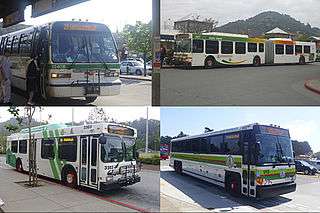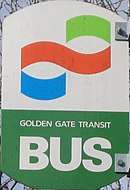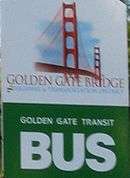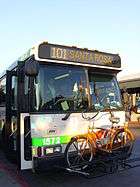Golden Gate Transit
Golden Gate Transit (GGT) is a public transportation system serving the North Bay region of the San Francisco Bay Area in California, United States. It primarily serves Marin and Sonoma counties, and also provides limited service to San Francisco and Contra Costa County.
 | |
 | |
| Parent | Golden Gate Bridge, Highway and Transportation District |
|---|---|
| Founded | January 1, 1972 |
| Headquarters | 1011 Andersen Drive San Rafael, CA |
| Service area | San Francisco Bay Area (San Francisco, Marin, Sonoma, Alameda, and Contra Costa Counties) |
| Service type | bus service |
| Routes | 28 |
| Stops | 720 |
| Hubs | San Rafael Transit Center, Santa Rosa Transit Mall |
| Stations | Copeland Street Transit Mall (Petaluma), Donahue & Terners (Marin City), El Cerrito del Norte BART, Redwood & Grant (Novato), San Anselmo Hub |
| Fleet | 160 buses |
| Daily ridership | 11,755 per weekday (FY 2016)[1] |
| Website | goldengatetransit.org |
Golden Gate Transit is one of three transportation systems owned and operated by the Golden Gate Bridge, Highway and Transportation District; the others are the Golden Gate Bridge and Golden Gate Ferry, both of which connect San Francisco and Marin County. Funding for cross-bridge "Transbay" bus service is partially subsidized by Golden Gate Bridge tolls in addition to traditional federal and state sources. GGT provides some bus service within Marin County under contract with Marin Transit.
Governance
Golden Gate Transit is constituted as a special district under California State Law, as evidenced by Assembly Bill 584, creating the Golden Gate Bridge, Highway and Transportation District (District). The District [2] consists of 19 directors from 6 Northern California counties:
- San Francisco: 9 Directors; 1 Director appointed by the Mayor, 4 Directors are elected members of the Board of Supervisors, and 4 Directors are non-elected public members appointed by the Board of Supervisors.
- Marin: 4 Directors; 2 Directors are elected members of the Board of Supervisors, 1 Director is an elected member of the Council of Mayors and Councilmembers and is appointed by the Board of Supervisors, and 1 Director is a non-elected public member appointed by the Board of Supervisors.
- Sonoma: 3 Directors; 1 Director is an elected member of the Board of Supervisors, 1 Director is an elected member of the Council of Mayors and Councilmembers and is appointed by the Board of Supervisors, and 1 Director is a non-elected public member appointed by the Board of Supervisors.
- Napa, Mendocino, and Del Norte: 1 Director each; Directors are non-elected public members appointed by each county's Board of Supervisors.
Funding
Unlike most transit agencies, which are funded by local taxes, Golden Gate Transit is subsidized by tolls collected at the Golden Gate Bridge.[3] According to the mandate presented by Assembly Bill 584 passed by the California State Legislature on November 10, 1969, the District has no authority to levy taxes, nor can it fund intra-county bus services; only inter-county service can be subsidized by Bridge tolls. Certain Golden Gate Transit routes are funded by the Metropolitan Transportation Commission using Regional Measure 2 funds.[4]
History



Golden Gate Transit has alleviated congestion on the Golden Gate Bridge and along the Golden Gate Corridor since 1972. A history of service is listed below.[5][6]
Inception (1960s)
The Golden Gate Bridge, operated by the Golden Gate Bridge and Highway District, saw a huge increase in the number of crossings every year, from just 3.3 million in its opening year (1937) to 28.3 million 30 years later (1967). With average annual increase in traffic of 70% over 30 years, the Bridge was close to reaching its saturation point. As congestion mounted, several studies were undertaken to identify alternate means of travel between Marin County and San Francisco. The "San Francisco-Marin Crossings" report of May 1967 looked at the possibility of building another bridge. The District also considered adding a second deck to the Bridge. Several traffic-relief measures were implemented during the 1960s, including reversible lanes, which were inaugurated on the Bridge in 1963, and a first-of-its kind one-way toll collection system in 1968 that has since been used on other bridges throughout the world.
However, traffic continued to mount. The Marin County Transit District (MCTD) (now Marin Transit) considered taking over the existing Greyhound system as a commuter service to San Francisco. Greyhound provided transit between Marin County and San Francisco at the time and it was unprofitable, so Greyhound management planned to abandon it. As air pollution increased and congestion took its toll on commuters, San Francisco, Marin, and Sonoma counties asked the District to implement a bus transit plan developed by MCTD. The plan called for bus service from neighborhoods in Marin and Sonoma counties to the San Francisco Financial District and Civic Center areas.
Bus service begins (1969 to 1970s)
By the late 1960s, the Bridge was operating at capacity during the morning commute period. Original Bridge construction bonds were due to be retired in 1971, and the District had approximately $22.8 million in reserves. On November 10, 1969, the California State Legislature passed Assembly Bill 584 authorizing the District to develop a transportation facility plan for implementing a mass transportation program in the Golden Gate Corridor. This included any and all forms of transit, including buses and ferries. The word "Transportation" was added to the District's name at that time to indicate its new commitment to public transportation. The legislature did not give the District the authority to levy taxes. Legislation also restricted the use of Bridge tolls to support only regional (inter-county) transit services, not local (intra-county) transit services.
On 10 December 1971, Assembly Bill 919 was passed, requiring the District to develop a long-range transportation program for the corridor. After an extensive public participation program, including 21 public hearings in 6 counties, a unified system of buses (Golden Gate Transit) and ferries (Golden Gate Ferry) emerged as the best means to serve the people of Marin and Sonoma counties.
Bus service began in December 1970 when the District initiated a shuttle service to the Sausalito Ferry Terminal using 5 buses leased from Greyhound on 4 bus routes driven by 4 drivers. The District soon bought 132 buses to start its operations.
In September 1971, the District hired 30 experienced Greyhound drivers to operate the new bus service. GGT began operating local bus service in December 1971 under contract with MCTD, and the District established Transbay commute service in January 1972, taking over the Greyhound operations.[7] The initial GGT system was operated with 152 buses (including 20 leased buses) and facilities in Novato and Santa Rosa, as well as a temporary facility in San Rafael. In 1974, the District opened its permanent bus administration and central maintenance facility at 1011 Andersen Drive in San Rafael.
As a result of these efforts, traffic growth across the Bridge was held to a manageable level.
System expansion (1980s to 1990s)
With declining ridership due to relocation of San Francisco jobs to the suburbs, Transbay commuter bus service was significantly reduced in 1987. However, with the increase of jobs in Marin County, the District initiated inter-county commuter service from Sonoma County to Marin County employment centers in 1990.
In 1992, the District and the City of San Rafael opened the C. Paul Bettini Transit Center in San Rafael (also called San Rafael Transit Center). The transit station immediately became GGT’s busiest transit station and transfer point.
In 1993, acting on behalf of MTC, GGT began operating regional bus service between Marin and Contra Costa counties via the Richmond-San Rafael Bridge. That same year, the district initiated an Americans with Disabilities Act (ADA) inter-county complementary paratransit service through an agreement with Marin County and its paratransit contractor, Whistlestop Wheels.
The District went online in 1997, allowing passengers and visitors to browse through the District's history and updates. (Bus schedules were added to the website in 2004.) Also in 1997, the District installed bicycle racks at more than 40 key bus stops. In 1999, it installed bicycle racks on all GGT buses shorter than 45 feet (14 m).
Club Bus program
The Club Bus program administered by Golden Gate Transit provided commuter clubs with contract support for subscription bus service on routes not otherwise operated. The program also provided a 30% subsidy for the cost of service.[8] The program required the formation of not-for-profit organizations to collect riders' subscription fees and develop schedules.
The Marin Commute Club, which began service in 1971, had direct service from Marin County to three University of California, San Francisco locations (Parnassus Campus, Mission Bay Campus, San Francisco General Hospital) not otherwise served by Golden Gate Transit. Daily ridership dropped from 300 in 1978 to 55 in 2014, shortly before the service was discontinued.[9][10]
The Valley of the Moon Commute Club provided bus service to the San Francisco Financial District from the Sonoma Valley, which otherwise does not have direct bus service to San Francisco. It was created in 1973 and operated as part of the Club Bus program until 2011.[11][12] At its peak, the club had service on five buses. However, the economic downturn and changing travel patterns resulted in substantial service reductions and fare hikes. By late 2010, service had been cut to one round-trip with a monthly subscription fee of $350.[8] In February 2011, with the club on the brink of shutting down, service was transferred to a private tour company.[13] Due to further ridership declines, service was discontinued in May 2014.[11]
System contraction (2000s to present)
Significant service reductions were implemented in March and November 2003 as a result of a declared fiscal emergency. Several bus routes with low ridership were discontinued; as a result of the restructuring, all GGT service to the Sonoma Valley and Sebastopol was eliminated. Ferry Feeder bus routes to the ferry terminals in Larkspur and Sausalito were also discontinued.
In 2004, Measure A was passed by the voters of Marin County. The sales tax measure established a new funding source for MCTD. That same year, the District signed a new 18-month contract with MCTD to provide local bus service within Marin County. This contract and the passage of Measure A helped usher in a new stage in local and regional service integration, with MCTD assuming more control over local bus service planning and operation.
The District's contract with MCTD was extended again in 2006 and 2010. MCTD issued a notice to terminate the 2010 contract, which was in effect until 2014, in 2012. After lengthy negotiations, a new contract that reduced the number of bus routes operated by GGT was signed in 2013 and remains in effect until 2016.
In 2006, the District installed luggage bay bicycle racks on all 45-foot (14 m) GGT buses. Also in 2006, the District implemented a new regional smart card fare payment system called TransLink (now Clipper) on all bus and ferry services as a "pre-launch" test. In 2008, GGT tested a hydrogen fuel cell bus in conjunction with AC Transit.[14]
On 15 June 2009, Golden Gate Transit began operating Route 101,[15] an all-day bus service between Santa Rosa and San Francisco that provides limited-stop service similar to many Bus Rapid Transit operations. Introduced initially as a weekday-only route, service was expanded to Saturdays on 19 June 2010, and to Sundays and holidays on 11 September 2011. For a description of this service, click here.
On 13 December 2015, Route 42 merged with Route 40, which was expanded to operate daily. The next day, Golden Gate Transit began operating Route 580,[16] a commute bus service that provides service from the East Bay communities of Emeryville, Berkeley, and Albany to San Rafael. The latter experiment failed and Route 580 was discontinued on 12 September 2016.
Beginning 12 June 2016, Marin Transit Routes 22 and 49 were no longer operated by Golden Gate Transit.[17] This signified the largest switch of bus route operations from Golden Gate Transit to private contractors since 19 June 2015, when several supplemental local routes were transferred.
Service area
Golden Gate Transit serves cities and communities in five Bay Area counties: San Francisco, Marin, Sonoma, Alameda, and Contra Costa.[18]
Cities, communities, and attractions served
| County | Cities and communities | Attractions |
|---|---|---|
| Contra Costa County |
| |
| Marin County |
| |
| San Francisco |
|
|
| Sonoma County |
Routes
Fleet
Golden Gate Transit has operated a variety of mostly suburban-style coaches fitted with high-back seats, overhead luggage bins, and reading lights since its inception. The full fleet has been equipped with wheelchair lifts since 1997 for accessibility.[19] Bike racks were installed on buses beginning in 1999 as part of the Bike Racks on Buses program.[20]
Current fleet
The active fleet consists of 147 buses owned by Golden Gate Transit as of 2020. An additional 10 buses are part of the reserve fleet. GGT also operates 27 buses owned by Marin Transit, as described here.
| Year | Fleet numbers | Quantity | Make | Model | Length (feet) | Floor type | Number of seats | Bike rack style | Propulsion | Image |
|---|---|---|---|---|---|---|---|---|---|---|
| 2010 (901-923) 2012 (924-955) 2015 (956-980) |
901-980 | 80 | MCI | D4500CT | 45 | High | 57 | Luggage bay | Diesel |  |
| 2019 | 1901-1967 | 67 | Gillig | Low Floor | 40 | Low | 39 | Front mounted | Diesel-electric hybrid |
Historical fleet
| Year | Fleet numbers | Quantity | Make | Model | Length (feet) | Number of seats | Wheelchair lift | Image | Current status |
|---|---|---|---|---|---|---|---|---|---|
| 1971 (701-812) 1972 (813-860) | 701-860 | 160 | GM | New Look | 40 | 45 | No |  | Retired by 1997; bus 812 retained for historical purposes |
| 1982 | 1001-1016 | 16 | GM | Advanced Design | 40 | 43 | Yes | NA | Retired by 1998 |
| 1983 | 1017-1067 | 51 | GM | Advanced Design | 40 | 41 | Yes | NA | Retired by 2000 |
| 1986 | 501-504 | 4 | Gillig | Phantom | 30 | 26 | Yes | NA | Retired in 2003 |
| 1987 | 401-421 | 21 | MCI | 102A3 | 40 | 45 | Yes | NA | Retired by 2001 |
| 1989 | 1101-1180 | 80 | TMC | RTS | 40 | 39 | Yes | NA | Retired in 2003 |
| 1990 | 514-521 | 8 | New Flyer | D60HF | 60 | 62 | Yes | NA | Purchased used from SamTrans in 2003; retired in 2007 |
| 1991 | 1181-1243 | 63 | TMC | RTS | 40 | 40 | Yes |  | Retired by 2012 |
| 1994 | 1401-1441 | 41 | Flxible | Metro | 40 | 45 | Yes | .jpg) | Retired by 2008 |
| 1996 (601-630) 1997 (631-632) 1999 (633-646) | 601-646 | 46 | MCI | 102DL3 | 45 | 57 | Yes |  | Retired by 2015 |
| 1997 | 1301-1330 | 30 | NovaBus | RTS | 40 | 43 | Yes |  | Retired by 2010 |
| 2000 | 1251-1264 | 14 | NovaBus | RTS | 40 | 39 | Yes |  | Retired by 2016 |
| 2001 | 505-508 | 4 | NovaBus | RTS | 30 | 27 | Yes |  | Retired in 2016 |
| 2003 | 691-696 | 6 | MCI | D4500 | 45 | 57 | Yes |  | Retired in 2016 |
| 2003 | 1501-1580 | 80 | Orion | V | 40 | 41 | Yes |  | Most units were pulled from service in 2019 Remaining units in contigency fleet |
Fares and transfer policies
Fares
Golden Gate Transit charges different fares, depending on distance (zones) traveled and method of payment.[21] Fares can be paid with cash or Clipper card. Fares effective 1 July 2019:
| Adult cash fare | San Francisco | Marin County | Sonoma County | East Bay | |||
|---|---|---|---|---|---|---|---|
| Bus zone To/from |
1 | 2 | 3 | 4 | 5 | 6 | |
| 1 | $4.50* | $7.00 | $7.50 | $8.75 | $13 | $13 | $11.75 |
| 2 | $7 | $2 | $8.75 | $9.50 | $6.25 | ||
| 3 | $7.50 | $8.25 | $8.75 | ||||
| 4 | $8.75 | $7 | $7 | ||||
| 5 | $13 | $8.75 | $8.25 | $7 | $4.50 | $11.75 | |
| 6 | $13 | $9.50 | $8.75 | $7 | |||
| East Bay | $11.75 | $6.25 | $11.75 | $4.50 | |||
| Adult Clipper fare | San Francisco | Marin County | Sonoma County | East Bay | |||
| Bus zone To/from |
1 | 2 | 3 | 4 | 5 | 6 | |
| 1 | $3.60* | $5.60 | $6 | $7 | $10.40 | $10.40 | $3.50 |
| 2 | $5.60 | $1.80 | $7 | $7.60 | $5 | ||
| 3 | $6 | $6.60 | $7 | ||||
| 4 | $7 | $5.60 | $5.60 | ||||
| 5 | $10.40 | $7 | $6.60 | $5.60 | $3.60 | $9.40 | |
| 6 | $10.40 | $7.60 | $7 | $5.60 | |||
| East Bay | $3.50 | $5 | $9.40 | $2 | |||
Note:
- * Travel within San Francisco is to/from the Golden Gate Bridge Toll Plaza or the Presidio (Richardson Avenue and Francisco Street) only.
Discount fares are available to youth (ages 5 through 18), senior (ages 65 and over), disabled (![]()
Transfers


Transfers are issued upon request only by the farebox at the time of cash fare payment. Clipper automatically tracks transfers.[22]
From bus to bus: Transfers are valid for 3 hours for intra-county travel and 4 hours for inter-county travel. Transfers may be used up to 3 times to complete a one-way journey.
From bus to ferry: Deposit full Transbay fare (see ferry fare table here) in the farebox when boarding the bus, and the bus operator will issue a Transbay transfer.
From ferry to bus: Ferry customers wishing to transfer to the bus must use Clipper unless transferring to a designated ferry shuttle.
To/from other agencies: GGT has interagency transfer agreements with several connecting transit agencies.[22] Transfers to/from Marin Transit (including West Marin Stagecoach) work the same as regular GGT transfers. Transfers good for partial or full fare are also available to/from AC Transit, Petaluma Transit, San Francisco Muni, Santa Rosa CityBus, SMART, SolTrans, Sonoma County Transit, and WestCAT.
Interagency pass programs
Golden Gate Transit accepts specific passes issued by Marin Transit and Sonoma County Transit.
Marin Transit passes are available for unlimited travel within Marin County for 1, 7, or 31 consecutive calendar days. Passes are valid on all Marin Transit routes as well as the Marin County portions of all GGT routes; they are not valid for travel outside Marin County.
| Fare category | 1-day pass | 7-day pass | 31-day pass |
|---|---|---|---|
| Adult | $5 | $20 | $80 |
| Youth (5 through 18) | $2.50 | $10 | $40 |
| Senior (65 and over), Disabled ( |
$2.50 | $10 | $25 |
The monthly Sonoma Super Pass ($262.50 adult, $131.25 senior/disabled, $147 youth) provides unlimited rides on all GGT routes within Sonoma County only. The pass is not valid for travel outside Sonoma County.
Bus garages
Golden Gate Transit operates 4 divisions. All 4 yards provide bus parking and 3 also act as maintenance centers. Buses that pull out from one yard do not necessarily pull into the same yard at the end of the service day.
The San Rafael division, also known as D1, is located at 1011 Andersen Drive. It serves as the primary bus depot for GGT and houses administrative offices and a heavy maintenance center. Major maintenance facilities are available for bus repairs and reconstruction, including a workshop, motor repair unit, engine rebuild unit, transmission shop, upholstery shop, bus wash, and body component area. This yard operates 24 hours per day, every day including holidays.
The Novato division, D2, is located on Golden Gate Place just east of Redwood Boulevard. This secondary yard operates primarily on weekdays. Facilities includes bus parking, a bus wash, and a repair unit.
The Santa Rosa division, D3, is located at the northwest corner of Piner Road and Industrial Drive. This secondary yard is the sole Golden Gate Transit facility in Sonoma County. This facility is similar to D2 but also features a free park-and-ride lot and enclosed passenger waiting area. D3 is in operation daily, including holidays.
The new San Francisco bus lot, D4, opened 24 February 2014 and is located under the I-80 skyway between Third and Fourth streets. It serves as a bus layover lot, and no maintenance is performed at this location. D4 is in operation weekdays only from 7 a.m. to 7 p.m. The new bus lot replaces the previous division at Eighth and Harrison streets, which provided minor maintenance facilities and was in operation every day including holidays since its opening in 2003. Previously, D4 was located at the southeast corner of Main and Folsom streets.
References
- Golden Gate Transit: Research Library
- Golden Gate Bridge, Highway and Transportation District (27 April 2015). "Golden Gate: Board of Directors". Golden Gate Bridge, Highway and Transportation District. Retrieved 6 August 2015.
- Golden Gate Bridge, Highway and Transportation District (15 June 2007). "Golden Gate Transit: History". Golden Gate Bridge, Highway and Transportation District. Retrieved 12 November 2007.
- Golden Gate Bridge, Highway and Transportation District (12 February 2008). "SRTP-Chapter 1" (PDF). Golden Gate Bridge, Highway and Transportation District. Retrieved 22 February 2008.
- Golden Gate Transit Timeline
- Jeff Greer (1971-12-27). "Greyhound's Stormy Era Of Commute Runs Ending". Daily Independent Journal. San Rafael, California. pp. 1–25.
- "Commute Club Struggles to Break Even". Sonoma Patch. December 7, 2010. Archived from the original on March 23, 2012.
- "UCSF Distinguished Faculty Members Receive Public Service Awards" (Press release). University of California, San Francisco. May 26, 1978 – via Google Books.
- "Chapter 11: Cross Campus Support". UCSF 2014 Long Range Development Plan (PDF). University of California, San Francisco. 2014. p. 133.
- Hoban, Bill (April 1, 2014). "Commute club needs more riders". Sonoma Index-Tribune.
- "Sonoma/SF commute club running out of gas". Sonoma Valley Sun. December 2, 2010. Archived from the original on December 7, 2010.
- Moore, Derek (February 28, 2011). "Petaluma bus company rescues Sonoma Valley commuter club". The Press Democrat. Retrieved September 11, 2018.
- Golden Gate Bridge, Highway and Transportation District (13 February 2008). "zebdebut". Golden Gate Bridge, Highway and Transportation District. Archived from the original on 11 March 2008. Retrieved 14 February 2008.
- servicechanges_jun09
- Golden Gate Bridge, Highway and Transportation District. "services". Golden Gate Bridge, Highway and Transportation District. Retrieved 6 August 2015.
- Golden Gate Transit Fleet
- Golden Gate Transit Expands Bike Carrying Capacity with New 3-Position Bike Racks
- "Fare Tables". Golden Gate Transit. Retrieved December 25, 2019.
- Golden Gate Bridge, Highway and Transportation District (10 June 2018). "Golden Gate Transit Guide, Summer 2018". Golden Gate Bridge, Highway and Transportation District.